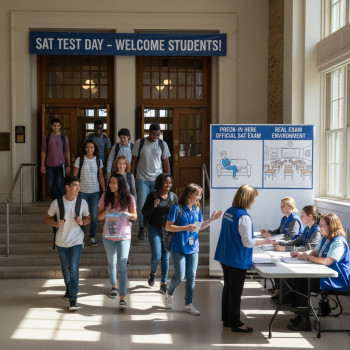Start Early, Stay Calm: Why a 9th-Grade SAT Roadmap Works
Imagine the SAT as a marathon rather than a sprint. You wouldn’t wait until the morning of a marathon to start running; you’d train for months. Starting in 9th grade gives you the luxury of time—time to build skills, learn how you learn, and recover from setbacks.
But “long-term” doesn’t mean “lazy.” It means a deliberate, enjoyable rhythm that layers math fluency, reading instincts, and test-taking tactics year by year. In this post I’ll walk you through a practical, flexible roadmap from 9th to 12th grade, offer weekly and seasonal examples, and show how targeted support—like Sparkl’s personalized tutoring with 1-on-1 guidance, tailored study plans, expert tutors, and AI-driven insights—can be plugged in when it best suits you.
Quick SAT Reality Check: What You Should Know
The structure and score
The SAT tests two broad areas: Evidence-Based Reading and Writing (EBRW) and Math. Scores combine for a 400–1600 scale. Timing, question styles, and scoring rules matter, but the core is simple: accuracy, strategy, and stamina.
When students typically take the SAT
Most students sit the SAT in 11th or early 12th grade, after they’ve taken the core high school courses. But starting preparation earlier—informally at first—gives you stronger fundamentals and less pressure later on.
Year-by-Year Roadmap: 9th Through 12th Grade
Below is a clear timeline. Treat it as a template: everyone adapts the tempo to their life, coursework, and goals.
| Grade | Focus | Key Actions | Outcome |
|---|---|---|---|
| 9th Grade | Foundation |
|
Comfort with core skills and clear diagnosis |
| 10th Grade | Skill development |
|
Steady improvement and study routine |
| 11th Grade | Test season |
|
Target score within reach; application prep begins |
| 12th Grade | Polish & finalize |
|
Finalized score; confident test-day routine |
How to use this table
Use the table above to set mileposts. Each year should have a primary goal (skill, volume, polish) and 2–3 measurable actions. Checking boxes builds confidence; momentum is a score multiplier.
Month-to-Month: What 9th Grade Looks Like
Ninth grade is about building habits, not chasing a score. Here’s a realistic six-month starter plan.
- Months 1–2: Reading and math baseline. Read one well-written article or essay per week. Refresh core algebra concepts (linear equations, slopes, simple quadratics).
- Months 3–4: Light practice. Do two 30–45 minute SAT-style practice sets per week (one reading, one math). Keep an error log.
- Months 5–6: Boost vocabulary through context rather than rote lists; start timed sections once a month to get comfortable with pacing.
Small consistent actions win. A 20–30 minute daily habit beats a weekend cram every time.
Section Strategies That Build Over Time
Reading and Writing: Think habit before hacks
Strong readers are curious readers. Build the habit of annotating and summarizing. Practice with diverse genres: science articles, literary passages, historical documents, and opinion pieces. Here are techniques that mature across years:
- Annotate for main idea and author’s tone.
- Summarize each paragraph in a phrase or two.
- For grammar, learn the common rules—subject-verb agreement, verb tenses, pronoun clarity—and then practice editing under time pressure.
- Gradually reduce time per passage from untimed to exam-paced to build fluency.
Math: From fragile to fluent
Math is cumulative. If algebra foundations are shaky, later topics feel impossible. A long-term plan focuses first on conceptual clarity, then on speed.
- Early years: master arithmetic fluency, linear and quadratic equations, and basic geometry facts.
- Middle years: tackle more advanced algebra, functions, and problem solving. Start learning shortcut techniques and when to use them.
- Later years: timed practice and error analysis—learn which types of problems cost you the most time.
Practice Tests: The Backbone of Progress
Practice tests are measurement and training simultaneously. They reveal weaknesses, build endurance, and teach time management.
When to start full-length tests
Begin with one baseline full-length SAT-style practice test in 9th grade to set a starting point. Then move to a cadence that increases over time:
- 9th grade: 1–2 diagnostic tests in the year.
- 10th grade: 2–4 tests, spaced across the year.
- 11th grade: every 4–6 weeks during practice season; mimic test-day conditions.
- 12th grade: 1–2 final dress rehearsals before the real thing.
How to analyze a practice test
Don’t just look at your score. Break it down by question type, time management, and careless errors. Create an error log with columns:
- Question ID
- Type (algebra, geometry, long passage, grammar rule)
- Reason wrong (conceptual, careless, timing)
- Fix (what you will do to avoid repeating it)
Sample Weekly Study Plan (10–12 Hours/Week During Peak Months)
Below is a sample weekly plan you can scale up or down. During school breaks you might double this; during finals week, trim it.
| Day | Activity | Duration |
|---|---|---|
| Monday | Timed math practice (focused topic) + review | 90 minutes |
| Tuesday | Reading passage practice + vocabulary in context | 60 minutes |
| Wednesday | Grammar practice and short timed section | 60 minutes |
| Thursday | Mixed practice set + error log review | 90 minutes |
| Friday | Light review: flashcards, reading for pleasure | 30 minutes |
| Saturday | Full timed section or practice test block | 2–3 hours |
| Sunday | Rest or passive review (listen to an audiobook, read) | Flexible |
Why this works
It mixes deliberate practice, recovery, and reflection. One hard fact about studying is that rest and variety amplify gains.
Realistic Examples and Mini Case Studies
Let’s look at two short examples to show how paths can differ but still succeed.
Case A: The Steady Improver
Emma started 9th grade with a baseline score around 950. She read widely, focused on algebra in 10th, and took PSAT practice tests. With a tailored plan in 11th and 1-on-1 guidance for tough math topics, she improved to 1280 by spring of junior year. Her secret: consistent, small practices and honest error logs.
Case B: The Late Accelerator
Raj didn’t begin focused prep until late 10th grade. He had strong math fundamentals but struggled with pacing. He ramped up practice tests, added weekly timed sections, and used targeted tutoring for pacing strategies. Within a year his score jumped 200 points. He concentrated effort where it mattered most instead of trying to reinvent his whole study routine.
Both students used tailored approaches, and both could have amplified gains earlier with individualized coaching—Sparkl’s personalized tutoring, for instance, can slot in 1-on-1 guidance and tailored study plans precisely when a student needs them.
How to Adjust the Roadmap for Busy Schedules
Life is noisy: sports, clubs, family obligations. The best schedule is the one you can keep. If you have only 4–6 hours weekly, prioritize:
- One focused math session
- One reading session with notes
- One mixed timed set or short practice test
Use pockets of time—commute audio for vocabulary, flashcards between classes, and weekend blocks for concentrated work. A well-targeted tutor can help compress wasted effort into high-yield practice, and Sparkl’s expert tutors and AI-driven insights can help identify those high-yield moves quickly.
Test Day and Mindset: Small Things That Matter
You’ve done the work; now manage the day. Practice test-day rituals during your full-length practices so nothing is new on the actual day.
- Sleep and nutrition: aim for a regular sleep schedule in the week leading up to the test and a balanced breakfast the morning of.
- Materials checklist: acceptable ID, admission ticket, approved calculator, pencils, snacks for breaks.
- Warm-up: do a short 15–20 minute light practice the morning of to get in the groove—no heavy learning or obsessing over missed questions.
- Mindset: treat mistakes as data. The score reflects preparation plus strategy, not self-worth.
When to Consider Tutoring or a Coaching Boost
Tutoring isn’t only for students who are behind. Consider extra help when:
- Your practice tests plateau after several months
- You struggle with a specific content area that prevents overall progress
- You need accountability to build or maintain a consistent schedule
Targeted 1-on-1 tutoring, tailored study plans, and periodic expert check-ins can reduce months of trial-and-error. For many families, a mix of independent study and occasional expert coaching—like Sparkl’s personalized tutoring offering one-on-one guidance and AI-driven insights—creates a nimble, efficient path forward.
Tracking Progress Numerically: A Simple Metric System
Numbers turn anxiety into action. Track these three metrics monthly:
- Practice test score (total)
- Section accuracy rate (percent correct per section)
- Average pacing (minutes per question in dense sections)
Plot them on a simple chart or spreadsheet. If accuracy is rising but pacing isn’t, add more timed sections. If pacing is fine but accuracy is low, the fix is concept review.
Two Image Ideas


Wrapping Up: Your Four-Year Promise to Yourself
Starting SAT prep in 9th grade isn’t about early pressure—it’s about choice. You choose to make steady, intelligent progress rather than panicked last-minute efforts. The plan here gives you structure: build a foundation in 9th, grow and diagnose in 10th, intensify in 11th, and polish in 12th.
A few final reminders:
- Consistency beats intensity. Small, regular habits compound.
- Measure what matters: accuracy, pacing, and improvement over time.
- Ask for help when needed. Tailored coaching and one-on-one tutoring can accelerate progress and prevent wasted effort. Sparkl’s personalized tutoring—combining expert tutors, tailored study plans, and AI-driven insights—fits naturally into a long-term plan when you need focused guidance.
You don’t have to follow this roadmap perfectly. Treat it as a flexible map: know your direction, check in regularly, and course-correct when needed. With steady work, a curious mindset, and a plan that respects your life, you can enter test day calm, prepared, and ready to run your best mile of the marathon.
Final practical checklist
- Set a baseline practice test this month.
- Design a weekly plan you can stick to for three months.
- Keep an error log and review it weekly.
- Plan full-length practice tests on your calendar (quarterly or monthly depending on grade).
- Consider periodic tutoring for stubborn weak spots or accountability.
Start today: pick one small action—read an article, solve ten algebra problems, or schedule a diagnostic test. Four years from now you’ll be glad you did.














No Comments
Leave a comment Cancel